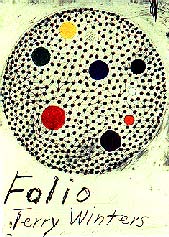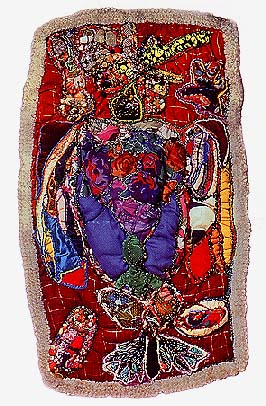

November Issue 1999
The Organic, Abstract Printmaking of Terry
Winters
Southeastern Center for Contemporary Art, Winston-Salem, NC
A Review
by Amy Funderburk

Terry Winters: Prints is being presented
by The Southeastern Center for Contemporary Art (SECCA). Featuring
more than 100 prints, this traveling exhibition represents the
first complete look at the print work of this American artist,
considered to be a major influence on contemporary abstract painting.
Winters uses the wide variety of printmaking media to create lithographs,
etchings, woodcuts, screen-prints, and linoleum cuts. In recent
works he has experimented with a computer and laser as well. He
began making prints after painting for more than a decade, and
devotes his attention equally to drawing, painting, and printmaking.
The work ranges from small monochromatic prints to large, highly abstract works. Images feature very organic forms, many resembling cellular structures. Some resemble a child's drawings. Many works are grouped together in series rather than images having individual titles. The titles given fit Winter's work, for they are as ambiguous as the prints themselves.
Visitors should probably begin viewing Winter's show with the grouping Fourteen Etchings, portfolio of fourteen etchings from 1988. Each monochromatic work, approximately 14" x 18", has the same format. A rectangular image is printed above and left of center, while a smaller rectangular image is beneath and right of center. A broad boundary of the white paper is left around the images in each work. Several of the works in this series have skulls, rib cages, and other bones as subjects within the lower, smaller image areas. Through technique as well as subject, these look like delicate x-rays. Within the larger image areas are abstract shapes that look like cellular close-ups of the subjects below. These are usually more linear in approach than the lower images. This portfolio of works helps the viewer to think in terms of the extreme microcosm -- of the abstract and non-objective within our own bodies. Beyond this body of prints, however, there is very little that is not completely abstract or non-objective within Winter's work.
To best appreciate abstract and non-objective work, one should view the lines, shapes, and colors as the elements of art in their purest forms. With Winter's work, however, it is easy to objectify the organic shapes, just as we find recognizable figures within clouds. The works in Graphic Primitives, portfolio of nine woodcuts with ink rinse,1998, each feature a black border, silver-gray negative spaces, and black lines. These lines create a network of shapes and contours; one work is reminiscent of an aerial view of a city, while one looks like microscopic cells or a type of netting. Thin white edges, presumably the white paper showing through, quiver between the black lines and gray negative shapes.
The larger Morula I, II, and III all read well from a distance, allowing their shapes to achieve the greatest impact on the viewer. Closer inspection reveals texture and a few intricacies. Each of these 1984 lithographs are 42 1/2" x 32 1/2", and have the soft look similar to charcoal or crayon that often results from the lithographic process. In Morula II, six large black circles that look like dust balls or round microscopic structures roll or rush to the viewer's left. This movement is indicated by several thin sepia tone lines running right to left; they have the same effect as the lines used to show movement in cartoons. A sepia line also runs across the top. A 3-D effect is created as some of the lines run across the top two spheres. Within each of the black balls is a little dimpled, netted texture. In the upper left, a small rectangle holds lighter, flatter, more tentative versions of the spheres with the netting more obviously rendered. This area and others like it in other works are reminiscent of an artist's sketchbook, in which various views or approaches are tried and one area more greatly developed. In Morula III, the spheres are more obviously netted to varying degrees. The result is the transparency of certain shapes. The spheres pile up in the lower right, where a white translucent orb floats on top of the three darkest ones. Small, lighter berry or cone shapes are found at the top in the center of the print. Morula I features a large sphere at the top of the paper, towering above a smaller orb below and left of center. There is less texture here; the concept of netting is barely there, but discernible. Lighter, pinecone-like shapes are included in the lower portion of the work. Behind the entire image, the background is shaded a darker gray at the top, which graduates to the white of the paper. A touch of brown is included at the bottom. The works in the Morula series explore movement and visual tension very successfully.
Despite Winter's seeming reliance on certain textures, forms, and organic motifs, there is a lot of variety within the range of works. Models for Synthetic Pictures, boxed portfolio of twelve etchings, 1994, is a series of etchings with color. These works are like a child's drawings, especially since the colors used are the three primaries -- red, yellow and blue. Again, black lines and negative spaces create the omnipresent cellular forms and netting. The primaries are usually used to fill in shapes. Most of the subjects in this series are like what you would see while looking under a microscope.
A wide variety exists within the works of Field Notes, boxed portfolio of 25 etchings from 1992. Each monochromatic image of different forms is approximately 8 1/2" x 11". Shapes create mysterious, invented creatures or objects. There is a wide value range here, from the warm white paper through a variety of grays, to the darkest black. My favorite of these prints depicts three layers of segmented shapes, like two turtle shells or UFO's floating one above another and over a larger similar shape at the bottom of the image. This work is created with a range of grays to black, with no white paper showing.
One of the most recent prints in the show is the 1996 lithograph Untitled. The image area is 18" x 24". Warm colors of red, orange and yellow, with some white paper showing through, glow invitingly behind a black screen. This partial barrier is created by a large circle with smaller circular forms within it. A push-pull is created between the obstruction of the black linear foreground and the warm background within this non-objective world.
Winters explores our perceptions of space while he gives us a lesson in the variety of printmaking media available to the artist. The show was organized by the Barbara Krakow Gallery, Boston, and Matthew Marks Gallery, New York. All the prints in this exhibition are from the collection of the artist's longtime friends Robert and Susan Sosnick from Detroit, who are avid collectors of his work.
 While you are at SECCA, do not miss Eyewinkers,
Tumbleturds, and Candlebugs: The Art of Elizabeth Talford Scott.
This first ever retrospective of quiltmaker Elizabeth Talford
Scott, born in 1916, includes over 45 quilts dating from 1930-1997.
If the name of the show doesn't draw you in, the smallest glimpse
of the work surely will. Scott learned the tradition of piecing
cloth from her mother and began quilting at the age of nine. Her
work, however, shatters the mold of traditional quiltmaking. Her
works are extremely tactile surfaces rich with a variety of materials
within the fiber. Stones, buttons, shells, bones, and other unexpected
materials are included within the embroidered and beaded fabrics.
The colorful, heavily stitched surfaces are decorated with fanciful
creatures, as well as more recognizable animal and plant forms.
Perhaps my favorite work is an umbrella that exists solely for
its decorative, textured form rather than function. Several quilts
are suspended so that viewers can admire the backs, some almost
as intricate as the fronts. Do yourself a favor and read Scott's
various statements, for they are as rich as her work and lend
a deeper understanding of it. I could give away what the three
words in her title means, but you should go discover Scott's visual
and verbal wisdom for yourself.
While you are at SECCA, do not miss Eyewinkers,
Tumbleturds, and Candlebugs: The Art of Elizabeth Talford Scott.
This first ever retrospective of quiltmaker Elizabeth Talford
Scott, born in 1916, includes over 45 quilts dating from 1930-1997.
If the name of the show doesn't draw you in, the smallest glimpse
of the work surely will. Scott learned the tradition of piecing
cloth from her mother and began quilting at the age of nine. Her
work, however, shatters the mold of traditional quiltmaking. Her
works are extremely tactile surfaces rich with a variety of materials
within the fiber. Stones, buttons, shells, bones, and other unexpected
materials are included within the embroidered and beaded fabrics.
The colorful, heavily stitched surfaces are decorated with fanciful
creatures, as well as more recognizable animal and plant forms.
Perhaps my favorite work is an umbrella that exists solely for
its decorative, textured form rather than function. Several quilts
are suspended so that viewers can admire the backs, some almost
as intricate as the fronts. Do yourself a favor and read Scott's
various statements, for they are as rich as her work and lend
a deeper understanding of it. I could give away what the three
words in her title means, but you should go discover Scott's visual
and verbal wisdom for yourself.
Both the Winters and Scott exhibits run through Feb. 6, 2000. In conjunction with the Winters show, the work of several local printmakers can be found throughout the building, including the serigraphs of the late Dr. Antony Swider in the McChesney Scott Dunn Auditorium Lobby. Swider's colorful works created through strong use of shape reveal his love of the landscape and were often influenced by his travels. In Memory: Works by Dr. Antony Swider runs through Nov. 28, 1999.
Amy Funderburk is an artist, teacher, writer,
art critic, and exhibitions coordinator living in Winston-Salem,
NC.
For further information check our NC Institutional Gallery listings
or call SECCA at (336)725-1904, e-mail at (general@secca.org),
or on the web at (http://www.secca.org).
Mailing Address: Carolina Arts, P.O. Drawer
427, Bonneau, SC 29431
Telephone, Answering Machine and FAX: 843/825-3408
E-Mail: carolinart@aol.com
Subscriptions are available for $18 a year.
Carolina Arts
is published monthly by Shoestring
Publishing Company, a subsidiary of PSMG, Inc.
Copyright© 2000 by PSMG, Inc., which published Charleston
Arts from July 1987 - Dec. 1994 and South Carolina Arts
from Jan. 1995 - Dec. 1996. It also publishes Carolina Arts
Online, Copyright© 2000 by PSMG, Inc. All rights reserved
by PSMG, Inc. or by the authors of articles. Reproduction or use
without written permission is strictly prohibited. Carolina
Arts is available throughout North & South Carolina.